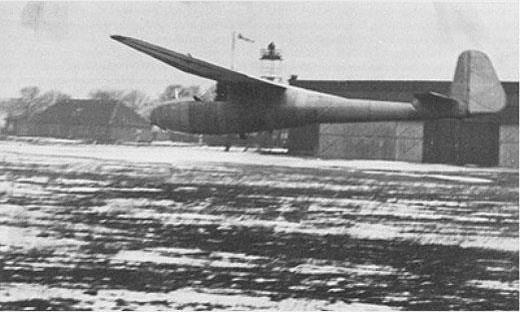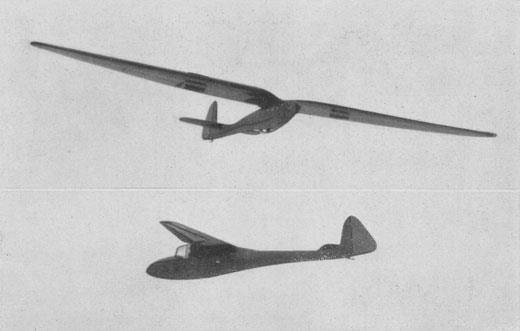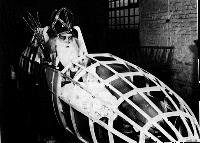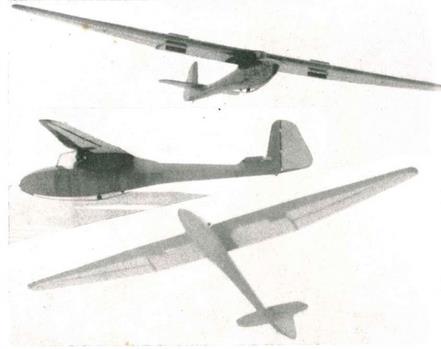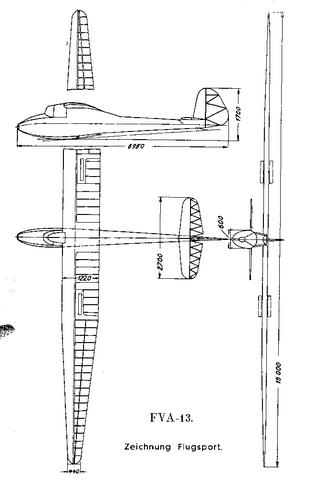| Type | Single seat glider | |
| Dimensions | Length 6,95 m, span 15 m, wing area 14,5 m2, aspect ratio 15,55, root chord 1,22 m, chord at tip 0,44 m, mean chord 1,22 m, width 0,6 m, stabilizer 1,67, fin 1,0 m2 m2 | |
| Weights | Empty 156 kg, max. flying weight 251 kg | |
| Performance | ||
| Type | Werk.Nr | Registration | History | |
| V1 | Built in 1939 by the FVA | |||
| V2 | Built in 1939 by the FAG Darmstadt | |||
In the spring of 1938, the FVA was invited to participate in the development of a unit glider that should be flown by all participants at the Olympic Games 1940 in which the glider was initially provided as an Olympic discipline. Two test machines to be built, which had to be completed by January 1, 1939. Because of the time and performance pressure the FVA decided build V1 in Aachen and build parallel the V2 by FAG Darmstadt
Herbert Kaulbach made in his thesis the general design and in detail the construction of the hull with the controls
The following extracts are taken from the thesis of Herbert Kaulbach, which he made with Prof. Wieselsberger.
"General Guidelines"
The task is: It is to design a glider that meets the guidelines for the Olympic unit glider. In following these guidelines will be briefly summarized as Du Vol Sans Moteur in 1938 set up by the Commission. Following the decisions of the International Olympic Committee aerobatics competitions are not allowed in the Olympic Games. Taking into account the planned tender, which provides goal-haul flights from 70-100km, a glider is to be considered, which could be in terms of performance compared with the conventional glider pattern Rhön-buzzard. The Olympic unit Glider therefore needs to be a high-performance machine. Nevertheless, many gliders are present, corresponding to these Bedingzingen, it was decided by the Commission, according to very specific aspects of a new Olympic machine to create. All interested nations to construct an Olympic-glider to February 1939 prescribed conditions. These aircraft will be presented in flight in February 1939 in Rome. On this occasion, a commission of engineers and such pilots will select the best machine and determine the future Olympic machine.
The gliders prepared by the CVSM guidelines must be taken into account in the design of the aircraft, are as follows:
Span 15m
Uniformity of the material: steel, plywood and pine
The machine should be able to get yourself some time floating on the water.
Dive brakes, the maximum speed in a dive to 200 km / h limit.
When setting up the driver's seat, it must be of a size of the pilot of 1.80 m.
Hull with skid without chassis
Driver seat with back parachute
Cabin width 600 mm
Empty weight maximum 160 kg
Load capacity 95 kg. If necessary, the load must be added to 95 kg through the attachment of weights. The secure attachment of extra weights is therefore considered at the design stage.
The above guidelines and the shortness of the resources available for development, design and construction of the aircraft and the time available make it necessary to design nothing fundamentally new, but to provide a reference to an existing pattern that has especially good flying characteristics, , When comparing gliders it is ultimately if a machine is intended for Olympic s, less on performance than the flying characteristics. It therefore seems pointless at design time to lose by considerations, by any means, the choice of special profiles, or the like if it can achieve the best performance. Rather, I consider it one of the basic requirements, an existing glider design as I said good flying properties to investigate even as all aspects , ie firstly to provide a mathematically perfect base and secondly to identify the simplest and most expedient in terms of structure. Since the machine may need to be copied by all the participating nations, proper drawings with parts lists, numbering, subdivision into modules, etc. is essential. The price for each machine in series production is expected to amount to approximately 2,500 RM.
This price also requires an intent on extreme simplicity design. A wing monoplane design brings by experience, a significant additional work as a result of the complicated fuselage wing transition, where this does not allow elaborate creations , especially since the use of light metal electron or duralumin, when used could provide cheap series production of these transitions, due to the condition 2 is not allowed. The simplest type, in this case, the high-decker, as the transitions can be done so that the wing is tight connected..
As the glider FVA-9 has the forementioned recognized good flight characteristics, the design of this glider used profiles, wings outline and high position of the rudder.. The new draft, however, in contrast to the glider FVA-9, which is braced, a self-supporting wing mounting. Since the machine must have particularly good maneuverability, as required in the calculation, at least to reach the curving speed of the FVA-9 and get hold as far as possible to that of the 10-FVA. More details to follow in the design specifications.
The draft stipulates: an empty weight of 120 kg. This is heavier than the FVA-9 (95kg), it is the design and the stringent strength requirements that are set for the Olympic gliders . To keep the landing speed at , 45 km / h and the surface load less than 15 kg/m2 was maintained, and elected to G / F = 14.8 kg / m². This results in an wing area of 14.5 m².
To get mathematically correct documentation, a model was made and measured in the wind tunnel of the Aerodynamic Institute of Aachen.
In order to do proper research regarding workshop production, a mock up was built, which makes it possible to determine the cheapest practical covering of the forward fuselage part and to make the installation of the pilot´s seat as low as possible and con to answer questions of the incorporation of controls, etc. of high importance.
The outline of the wing to the pattern of the already made FVA-9 adapt to a large extent. In the middle part of the wing outline is rectangular and decreases towards outward straight off. The chord at the fuselage is 1.22 m and remains in constant 2.75 m outwards. From 2,75 m chord tapers to the end of the wing = 0.44 m. The chord ratio is therefore 0.363. This ratio has been reported in a paper by Koning and Boelen as the best. The wing tip is then rounded. "
In contrast to the FVA-9, the design was for a cantilever wing mounting. For mounting reasons you chose them unsymmetric, ie, the left wing was attached to the hull, so that the right wing was attached to this projecting stub outside of the hull. By this trick a helper could be saved when upgrading.
After the construction of the "Olympic dinghy" then weighed 156 kg, and the load was exactly 95 kg. The International Commisssion selected from the three received from Germany , the "Olympia-Meise" by DFS, so that the two FVA-13 VI and V2 were in the FVA possession. They were destroyed in the war as well as other machin
Herbert Kaulbach made in his thesis the general design and in detail the construction of the hull with the controls
The following extracts are taken from the thesis of Herbert Kaulbach, which he made with Prof. Wieselsberger.
"General Guidelines"
The task is: It is to design a glider that meets the guidelines for the Olympic unit glider. In following these guidelines will be briefly summarized as Du Vol Sans Moteur in 1938 set up by the Commission. Following the decisions of the International Olympic Committee aerobatics competitions are not allowed in the Olympic Games. Taking into account the planned tender, which provides goal-haul flights from 70-100km, a glider is to be considered, which could be in terms of performance compared with the conventional glider pattern Rhön-buzzard. The Olympic unit Glider therefore needs to be a high-performance machine. Nevertheless, many gliders are present, corresponding to these Bedingzingen, it was decided by the Commission, according to very specific aspects of a new Olympic machine to create. All interested nations to construct an Olympic-glider to February 1939 prescribed conditions. These aircraft will be presented in flight in February 1939 in Rome. On this occasion, a commission of engineers and such pilots will select the best machine and determine the future Olympic machine.
The gliders prepared by the CVSM guidelines must be taken into account in the design of the aircraft, are as follows:
Span 15m
Uniformity of the material: steel, plywood and pine
The machine should be able to get yourself some time floating on the water.
Dive brakes, the maximum speed in a dive to 200 km / h limit.
When setting up the driver's seat, it must be of a size of the pilot of 1.80 m.
Hull with skid without chassis
Driver seat with back parachute
Cabin width 600 mm
Empty weight maximum 160 kg
Load capacity 95 kg. If necessary, the load must be added to 95 kg through the attachment of weights. The secure attachment of extra weights is therefore considered at the design stage.
The above guidelines and the shortness of the resources available for development, design and construction of the aircraft and the time available make it necessary to design nothing fundamentally new, but to provide a reference to an existing pattern that has especially good flying characteristics, , When comparing gliders it is ultimately if a machine is intended for Olympic s, less on performance than the flying characteristics. It therefore seems pointless at design time to lose by considerations, by any means, the choice of special profiles, or the like if it can achieve the best performance. Rather, I consider it one of the basic requirements, an existing glider design as I said good flying properties to investigate even as all aspects , ie firstly to provide a mathematically perfect base and secondly to identify the simplest and most expedient in terms of structure. Since the machine may need to be copied by all the participating nations, proper drawings with parts lists, numbering, subdivision into modules, etc. is essential. The price for each machine in series production is expected to amount to approximately 2,500 RM.
This price also requires an intent on extreme simplicity design. A wing monoplane design brings by experience, a significant additional work as a result of the complicated fuselage wing transition, where this does not allow elaborate creations , especially since the use of light metal electron or duralumin, when used could provide cheap series production of these transitions, due to the condition 2 is not allowed. The simplest type, in this case, the high-decker, as the transitions can be done so that the wing is tight connected..
As the glider FVA-9 has the forementioned recognized good flight characteristics, the design of this glider used profiles, wings outline and high position of the rudder.. The new draft, however, in contrast to the glider FVA-9, which is braced, a self-supporting wing mounting. Since the machine must have particularly good maneuverability, as required in the calculation, at least to reach the curving speed of the FVA-9 and get hold as far as possible to that of the 10-FVA. More details to follow in the design specifications.
The draft stipulates: an empty weight of 120 kg. This is heavier than the FVA-9 (95kg), it is the design and the stringent strength requirements that are set for the Olympic gliders . To keep the landing speed at , 45 km / h and the surface load less than 15 kg/m2 was maintained, and elected to G / F = 14.8 kg / m². This results in an wing area of 14.5 m².
To get mathematically correct documentation, a model was made and measured in the wind tunnel of the Aerodynamic Institute of Aachen.
In order to do proper research regarding workshop production, a mock up was built, which makes it possible to determine the cheapest practical covering of the forward fuselage part and to make the installation of the pilot´s seat as low as possible and con to answer questions of the incorporation of controls, etc. of high importance.
The outline of the wing to the pattern of the already made FVA-9 adapt to a large extent. In the middle part of the wing outline is rectangular and decreases towards outward straight off. The chord at the fuselage is 1.22 m and remains in constant 2.75 m outwards. From 2,75 m chord tapers to the end of the wing = 0.44 m. The chord ratio is therefore 0.363. This ratio has been reported in a paper by Koning and Boelen as the best. The wing tip is then rounded. "
In contrast to the FVA-9, the design was for a cantilever wing mounting. For mounting reasons you chose them unsymmetric, ie, the left wing was attached to the hull, so that the right wing was attached to this projecting stub outside of the hull. By this trick a helper could be saved when upgrading.
After the construction of the "Olympic dinghy" then weighed 156 kg, and the load was exactly 95 kg. The International Commisssion selected from the three received from Germany , the "Olympia-Meise" by DFS, so that the two FVA-13 VI and V2 were in the FVA possession. They were destroyed in the war as well as other machin
Segelflugzeug FVA 13 FFG Aachen.
Das Segelflugzeug FVA 13 der flugtechnischen Fachgruppe Aachen entstand im Rahmen des Wettbewerbes um das Olympia-Einheitssegelflugzeug. Es handelt sich im wesentlichen um eine Umkonstruktion der allen alten Fliegern wohlbekannten FVA „Blaue Maus". Im Gegensatz dazu ist die FVA 13 als freitragender Llochdecker in der
üblichen Holzbauweise ausgeführt. Flügel mit unsymmetrischem Flächenaiischluß linke Fläche =
größte Fläche einholmig, Sperrholznase. Das Flugzeug hat Bremsklappen, die in ausgefahrenem Zustand die Höchstgeschwindigkeit auf 200 km/h begrenzen, in eingefahrenem Zustand selbsttätig arretieren. Profile an der Wurzel GÖ 535, in halber Spannweite GÖ 549, am Ende M3. Schalen rümpf mit Hauptspanten zur Aufnahme der Flügelkräfte, Torsionsröhre zur Aufnahme der Leitwerkskräfte, Kufe aus Kiefernholz mit Gummifederung. Bei der
Montage werden alle Anschlüsse durch Schnellverbindungen hergestellt. Die Montage aus dem Segelflugzeug an häng er erfordert nur 3 Mann.
Leitwerk symmetrisch.
Spannweite 15 m, Flügelfläche 14,50 m2, Flu gel Streckung X = 1 : 15,50, Innentiefe 1,22 m, Außentiefe 0,44 m, Höhenleitwerksfläche 1,67 m2, Seiten leitwerksfläche 1 m2, Brems klappenfläche 0,338 m2.
Rüstgewicht 156 kg, Zuladung 95 kg, Fluggewicht 251 kg.
Mindest-Sinkgescliwindigkeit vs = 0,72 m/sec bei vb = 50,00 Beste Gleitzahle = 1 : 20 bei vK = 55,2 km/h u. vs = 0,76 m/s. Zulassung zu Winden-, Auto- und Flugzeugschlepp.
Das Segelflugzeug FVA 13 der flugtechnischen Fachgruppe Aachen entstand im Rahmen des Wettbewerbes um das Olympia-Einheitssegelflugzeug. Es handelt sich im wesentlichen um eine Umkonstruktion der allen alten Fliegern wohlbekannten FVA „Blaue Maus". Im Gegensatz dazu ist die FVA 13 als freitragender Llochdecker in der
üblichen Holzbauweise ausgeführt. Flügel mit unsymmetrischem Flächenaiischluß linke Fläche =
größte Fläche einholmig, Sperrholznase. Das Flugzeug hat Bremsklappen, die in ausgefahrenem Zustand die Höchstgeschwindigkeit auf 200 km/h begrenzen, in eingefahrenem Zustand selbsttätig arretieren. Profile an der Wurzel GÖ 535, in halber Spannweite GÖ 549, am Ende M3. Schalen rümpf mit Hauptspanten zur Aufnahme der Flügelkräfte, Torsionsröhre zur Aufnahme der Leitwerkskräfte, Kufe aus Kiefernholz mit Gummifederung. Bei der
Montage werden alle Anschlüsse durch Schnellverbindungen hergestellt. Die Montage aus dem Segelflugzeug an häng er erfordert nur 3 Mann.
Leitwerk symmetrisch.
Spannweite 15 m, Flügelfläche 14,50 m2, Flu gel Streckung X = 1 : 15,50, Innentiefe 1,22 m, Außentiefe 0,44 m, Höhenleitwerksfläche 1,67 m2, Seiten leitwerksfläche 1 m2, Brems klappenfläche 0,338 m2.
Rüstgewicht 156 kg, Zuladung 95 kg, Fluggewicht 251 kg.
Mindest-Sinkgescliwindigkeit vs = 0,72 m/sec bei vb = 50,00 Beste Gleitzahle = 1 : 20 bei vK = 55,2 km/h u. vs = 0,76 m/s. Zulassung zu Winden-, Auto- und Flugzeugschlepp.
